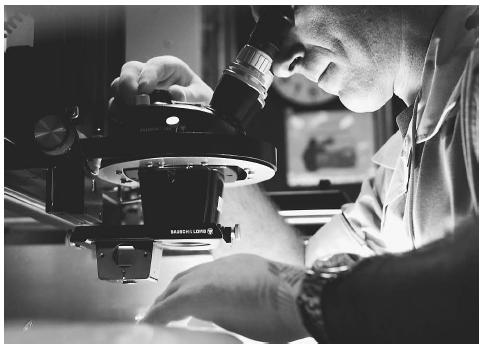Air Force Intelligence, United States
█ JUDSON KNIGHT
The intelligence-gathering efforts of the U.S. Air Force long predate its establishment as a separate military service in 1947. The Air Force has conducted extensive aerial surveillance, as well as air technical intelligence (ATI) operations—that is, the study of foreign aircraft themselves—since the end of World War I. As time has gone on, equipment and techniques have become more sophisticated, and involvement more widespread. Today's Air Combat Command includes a number of intelligence agencies.
Background. The U.S. Air Force has its roots in the Aeronautical Section of the U.S. Signal Corps, founded in 1907, and renamed the Aviation Section in 1914. This became the U.S. Army Air Service in 1918, and the Army Air Corps in 1926. In 1941, on the eve of World War II, the Department of the Army renamed its air section the United States Army Air Force. Two years after the end of World War II, the National Security Act of 1947 for the first time established the Air Force as a separate military service.
Throughout the twentieth century, the air services took part in aerial intelligence, particularly during the Cold

War and thereafter. In the 1950s, the United States launched one of its most successful spy aircraft, the U-2. Despite the shootdown of pilot Francis Gary Powers over the Soviet Union in 1960, as well as the passage of time and the aging of the craft, the U-2 remained in service during the 1990s. In addition to a number of surveillance craft such as the SR-71 Blackbird, deployed the Vietnam War, the Air Force made extensive use of satellites and unmanned, remotely piloted vehicles.
The Air Force and its predecessors also took a great deal of interest in ATI, which involves the study of aircraft, parts, and accessories. ATI has helped the United States, not only in the building of better aircraft, but also in targeting enemy defense plants for bombing runs. A byproduct of ATI work has also been advances in other areas, including computer systems in general, and automatic language translation technology in particular.
Air intelligence today. Most air intelligence work today is under the leadership of Air Combat Command (ACC). Headquartered at Langley, Virginia, ACC operates fighter, bomber, reconnaissance, battle-management, rescue, and theatre airlift aircraft, along with command, control, communication, and intelligence systems. Under its leadership are a number of intelligence-related Air Force activities, most notable of which are the Air Intelligence Agency (AIA) and the Air Force Technical Applications Center (AFTAC).
Established in October 1993, AIA grew out of the Air Force Intelligence Service, established in June 1972. AIA, which is tasked with intelligence collection, security, support for treaty monitoring, and electronic warfare, is headquartered at Kelly Air Force Base (AFB) in Texas. It consists of several components, including the 67th Information Operations Wing and the 690th Information Operations Group at Kelly, as well as the 70th Intelligence Wing at Barksdale AFB in Louisiana. Its three centers are the National Air Intelligence Center at Wright-Patterson AFB in Ohio, the Air Force Information Warfare Center at Kelly, and AFTAC, which it supports administratively, at Patrick AFB in Florida. In the mid-1990s, AIA included 12,600 activeduty personnel, along with 1,900 reservists and 2,400 civilians.
AFTAC is the sole Department of Defense agency operating and maintaining a global network of nuclear event detection sensors, the U.S. Atomic Energy Detection System (USAEDS). When the USAEDS detects a disturbance in the ground, water, atmosphere, or space, AFTAC laboratories undertake an analysis of the event to discover whether its causes relate to nuclear testing or deployment. It then reports its findings to national command authorities through Air Force headquarters. In the mid-1990s, AFTAC developed the U.S. National Data Center, which makes use of various ground and satellite centers for the monitoring of nuclear activities and treaty compliance worldwide.
█ FURTHER READING:
BOOKS:
Boyne, Walter J. Beyond the Wild Blue: A History of the United States Air Force, 1947–1997. New York: St. Martin's Press, 1997.
Clancy, Tom. Fighter Wing: A Guided Tour of an Air Force Combat Wing. New York: Berkley Books, 1995.
Gann, Ernest Kellogg. The Black Watch: The Men Who Fly America's Secret Spy Planes. New York: Random House, 1989.
Richelson, Jeffrey T. The U.S. Intelligence Community, fourth edition. Boulder, CO: Westview Press, 1999.
ELECTRONIC:
U.S. Air Combat Command. < http://www2.acc.af.mil/ > (April 13, 2003).
U.S. Air Force Intelligence and Related. Federation of American Scientists. < http://www.fas.org/irp/agency/usaf/ > (April 13, 2003).
U.S. Air Intelligence Agency. < http://aia.lackland.af.mil/ > (April 13, 2003).
SEE ALSO
Air Force Office of Special Investigations, United States
DoD (United States Department of Defense)
J-Stars
Photographic Interpretation Center (NPIC), United States National
Photography, High-Altitude
USSTRATCOM (United States Strategic Command)
Comment about this article, ask questions, or add new information about this topic: